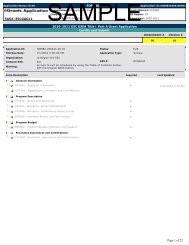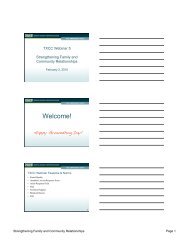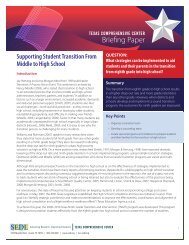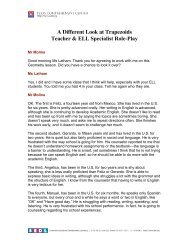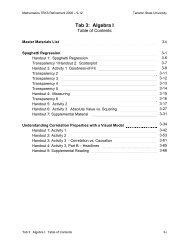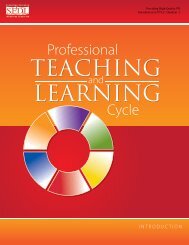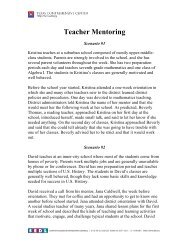School Improvement Grant (SIG) Committee of Practitioners (COP ...
School Improvement Grant (SIG) Committee of Practitioners (COP ...
School Improvement Grant (SIG) Committee of Practitioners (COP ...
You also want an ePaper? Increase the reach of your titles
YUMPU automatically turns print PDFs into web optimized ePapers that Google loves.
Welcome!<br />
<strong>School</strong> <strong>Improvement</strong> <strong>Grant</strong> (<strong>SIG</strong>) Webinar:<br />
<strong>Committee</strong> <strong>of</strong> <strong>Practitioners</strong> (<strong>COP</strong>) <strong>SIG</strong><br />
Discussion<br />
Jackie Burniske<br />
TXCC<br />
December 14, 2009<br />
Cory Green<br />
TEA<br />
Vivian Smyrl<br />
TEA<br />
1
Using Micros<strong>of</strong>t Office Live Meeting<br />
• Telephone<br />
• Feedback to Presenters<br />
• Question and Answer<br />
• Download PowerPoint<br />
• Shared Notes<br />
Jackie Burniske<br />
TXCC<br />
2
Technical Support: Telephone<br />
* 6 (star 6) on the telephone to mute<br />
# 6 (pound 6) on the telephone to unmute<br />
3
Technical Support: Attendees<br />
• Click on the upper left side to see a list <strong>of</strong> Attendees.<br />
• Your name will be in bold.<br />
• The presenters have a “person” icon next to their names.<br />
• The green box to the right <strong>of</strong> your name provides attendee<br />
feedback to the presenter.<br />
• You decide whether to leave the Attendee pane and other panes<br />
open during the presentation or to close them. You may move the<br />
pane(s) around on your computer screen.<br />
4
Technical Support: Feedback<br />
• The feedback selector is in the upper right hand corner <strong>of</strong> your<br />
computer screen.<br />
• Click on the arrow to the right <strong>of</strong> the green box.<br />
• The default is Proceed, with a green box.<br />
• Please select the appropriate color if you would like to send<br />
feedback to the presenter.<br />
Click<br />
here<br />
5
Technical Support: Q & A<br />
• Click on Q&A.<br />
• A text box appears: <br />
• You may also type comments to the presenter.<br />
• Click on Ask, and your question or comment is privately sent to<br />
the presenter.<br />
• You cannot ask another question until the presenter responds to<br />
your question or comment.<br />
6
Technical Support: Q & A (continued)<br />
• If you type a question, the facilitator will either 1) answer your question<br />
in writing or 2) wait until an appropriate time in the presentation and<br />
respond verbally to the whole group.<br />
• If you have questions or comments, you may type them now or at any<br />
time during the webinar.<br />
• Technical and content questions are appropriate.<br />
• Please select the hand icon to ask a question orally, using the telephone.<br />
7
Technical Support: Q & A (continued)<br />
• You were requested to log in to the webinar by typing your ESC/LEA/<br />
organization and the names <strong>of</strong> the participants in the room.<br />
• If you did not do so, right now we would like you to use the Q&A area to<br />
do this.<br />
• This way we can accurately identify who participated in the webinar.<br />
• Please type your ESC/LEA/organization and participants’ first and last<br />
names. For example: ESC 1 (Ann Apple, Brian Banana, Chuck<br />
Cantaloupe).<br />
8
Technical Support: Handouts<br />
• On the upper right side is an icon <strong>of</strong> white documents.<br />
• You may download the PowerPoint by selecting the<br />
documents icon.<br />
• A pane opens and you select the PowerPoint to download.<br />
9
Technical Support: Shared Notes<br />
• On the upper right side is the yellow notepad icon.<br />
• Information that pertains to the whole group is posted to<br />
shared notes.<br />
• You will see the message about muting the telephone, how to<br />
access materials, how to ask questions, and how to identify<br />
your participants.<br />
10
Title I, Part D, Subpart 2 <br />
Proposed Program <br />
Descrip8on Schedule <br />
Vivian Smyrl<br />
TEA
Texas<br />
Title I Priority <strong>School</strong>s <strong>Grant</strong><br />
Program Overview<br />
<strong>School</strong> <strong>Improvement</strong> <strong>Grant</strong><br />
Section 1003(g) Funding<br />
Final Regulations<br />
© 2009 by the Texas Education Agency<br />
Cory Green<br />
TEA
Funding History<br />
• 2007–08 = $125 million<br />
(est. Texas $11 million – SIP Academy)<br />
• 2008–09 = $491 million<br />
(est. Texas $45 million – SIP Academy)<br />
• 2009–10 level $545 million<br />
(Texas estimated $50 million)<br />
• <strong>School</strong> <strong>Improvement</strong> funds under ARRA $3 billion<br />
(Texas estimated $285 million)<br />
• Combined Amounts — (Texas estimated $335 million)<br />
17
Goal for FY09 and ARRA<br />
<strong>School</strong> <strong>Improvement</strong> Funds<br />
Target majority <strong>of</strong> funds to chronically lowachieving<br />
schools in the state, including high<br />
schools and their feeder schools, to implement<br />
robust and comprehensive reforms to transform<br />
school culture dramatically and increase student<br />
outcomes.<br />
18
• Formula to State<br />
• Competitive to LEAs<br />
Basics<br />
• LEAs identify the schools they want to improve,<br />
and then determine which one <strong>of</strong> the four<br />
intervention models is most appropriate for each<br />
school.<br />
• If a school has begun implementing one <strong>of</strong> the<br />
four models or components <strong>of</strong> one <strong>of</strong> the models<br />
within the last two years, it may apply to use <strong>SIG</strong><br />
funds to continue to implement the full model.<br />
19
Persistently Lowest-Achieving <strong>School</strong>s<br />
• Tier I and Tier II grants<br />
i. The academic achievement <strong>of</strong> the “all students”<br />
group in a school in terms <strong>of</strong> pr<strong>of</strong>iciency on the<br />
State’s assessments under section 1111(b)(3) <strong>of</strong> the<br />
ESEA in reading/language arts and mathematics<br />
combined<br />
ii. The school’s lack <strong>of</strong> progress on those assessments<br />
over a number <strong>of</strong> years in the “all students” group<br />
• List to be published on TEA web site<br />
• List submitted to USDE in SFSF II, RTTT, and<br />
<strong>SIG</strong> applications<br />
20
Priority 1<br />
• Greatest need. An LEA with the greatest need<br />
for a <strong>School</strong> <strong>Improvement</strong> <strong>Grant</strong> must have one<br />
or more schools in at least one <strong>of</strong> Tiers I, II, or III.<br />
21
Tier I <strong>Grant</strong>s<br />
• Any Title I school in improvement, corrective<br />
action, or restructuring that<br />
– is among the lowest-achieving 5% <strong>of</strong> Title I<br />
schools in improvement, corrective action, or<br />
restructuring in the state or<br />
– is a high school that has had a graduation rate<br />
as defined in 34 C.F.R. § 200.19(b) that is less<br />
than 60% over a number <strong>of</strong> years<br />
22
Tier II <strong>Grant</strong>s<br />
• Any secondary school that is eligible for, but<br />
does not receive, Title I funds that<br />
– is among the lowest-achieving 5% <strong>of</strong><br />
secondary schools in the State that are<br />
eligible for, but do not receive, Title I funds or<br />
– is a high school that has had a graduation rate<br />
as defined in 34 C.F.R. § 200.19(b) that is less<br />
than 60% over a number <strong>of</strong> years<br />
23
Tier III <strong>Grant</strong>s<br />
• Any Title I school in improvement, corrective<br />
action, or restructuring<br />
24
Priority 2<br />
• Strongest Commitment. An LEA that agrees to<br />
implement, and demonstrates the capacity to<br />
implement fully and effectively, one <strong>of</strong> the four<br />
rigorous interventions in each Tier I and Tier II<br />
school that the LEA commits to serve.<br />
25
Required Strategies – Tiers I, II<br />
LEAs receiving funds must agree to implement one <strong>of</strong><br />
the following rigorous interventions in Tier I/II school:<br />
• Turnaround Model<br />
• <strong>School</strong> Closure Model<br />
• Restart Model<br />
• Transformation Model<br />
Note: An LEA with nine or more Tier I and Tier II<br />
schools would not be able to implement the<br />
Transformation Model in more than 50% <strong>of</strong> those<br />
schools.<br />
26
The LEA must<br />
Turnaround Model<br />
i. replace the principal and grant the principal<br />
sufficient operational flexibility;<br />
ii. rehire no more than 50% <strong>of</strong> staff;<br />
iii. implement strategies to recruit, place, and<br />
retain staff with the skills necessary to meet the<br />
needs <strong>of</strong> the students in the turnaround school;<br />
iv. provide staff with ongoing, high-quality, jobembedded<br />
pr<strong>of</strong>essional development;<br />
(continued)<br />
27
The LEA must<br />
Turnaround Model<br />
v. adopt a new governance structure;<br />
vi. use data to identify and implement an<br />
instructional program that is research-based<br />
and aligned;<br />
vii. promote the continuous use <strong>of</strong> student data<br />
to inform and differentiate instruction;<br />
(continued)<br />
28
The LEA must<br />
Turnaround Model<br />
viii. provide increased learning time; and<br />
ix. provide appropriate social-emotional and<br />
community-oriented services and supports<br />
for students.<br />
29
Turnaround Model<br />
The LEA may also implement other strategies,<br />
such as<br />
– any <strong>of</strong> the required and permissible activities<br />
under the Transformation Model or<br />
– a new school model (e.g., themed, duallanguage<br />
academy).<br />
30
Closure Model<br />
The LEA closes the school and enrolls students<br />
who attended that school in other schools in the<br />
LEA that<br />
– are higher achieving;<br />
– are within reasonable proximity to the closed<br />
school; and<br />
– may include, but are not limited to, charter<br />
schools or new schools for which achievement<br />
data are not yet available.<br />
31
Restart Model<br />
The LEA converts a school or closes and reopens<br />
a school under a CMO or EMO.<br />
A Restart Model must enroll, within the grades it<br />
serves, any former student who wishes to attend<br />
the school.<br />
32
Transformation Model<br />
The LEA implements required activities in each <strong>of</strong><br />
the following strategies:<br />
(1) Developing and increasing teacher and school<br />
leader effectiveness<br />
(2) Comprehensive instructional reform strategies<br />
(3) Increasing learning time and creating<br />
community-oriented schools<br />
(4) Providing operational flexibility and sustained<br />
support<br />
33
Waiver Flexibility<br />
• The State may apply to USDE for waivers for<br />
Tier I schools to “start over” in the school<br />
improvement timeline.<br />
• Even though a school implementing the waiver<br />
would no longer be in improvement, corrective<br />
action, or restructuring, it may receive school<br />
improvement funds.<br />
34
Waiver Flexibility<br />
• The State may apply to USDE for waivers for<br />
Tier I Targeted-Assistance campuses to operate<br />
as <strong>School</strong>wide campuses.<br />
35
Waiver Flexibility<br />
• The State may apply to USDE for waivers for<br />
LEAs to use school improvement funds to serve<br />
Tier II secondary schools.<br />
36
Waiver Flexibility<br />
• The State may apply to USDE for waivers to<br />
– extend the period <strong>of</strong> availability <strong>of</strong> school<br />
improvement funds beyond September 30,<br />
2011, in order to make those funds available<br />
to the SEA and its LEAs for up to three years<br />
– (through September 30, 2013).<br />
37
Waiver Flexibility<br />
• An LEA may apply to USDE for waivers for any<br />
<strong>of</strong> the previous four State waivers, assuming the<br />
State does not apply for that waiver for the entire<br />
state.<br />
38
LEA Requirements<br />
• An LEA may apply for a <strong>School</strong> <strong>Improvement</strong><br />
<strong>Grant</strong> if it has one or more schools that qualify<br />
under the State’s definition <strong>of</strong> a Tier I or Tier III<br />
school.<br />
• An eligible LEA may also apply to serve Tier II<br />
schools.<br />
39
LEA Requirements<br />
• An LEA must monitor each Tier I and Tier II<br />
school that receives school improvement funds,<br />
including<br />
i. establishing annual goals for student<br />
achievement on the State’s assessments in<br />
both reading/language arts and mathematics<br />
and<br />
ii. measuring progress on the leading indicators<br />
in Section III <strong>of</strong> these requirements.<br />
40
LEA Requirements<br />
• If an LEA implements a Restart Model, it must<br />
hold the charter school operator, CMO, or EMO<br />
accountable for meeting the final requirements.<br />
41
LEA Application Requirements<br />
i. Identify the Tier I, Tier II, and Tier III schools it<br />
commits to serve.<br />
ii. Identify the intervention for each Tier I and Tier<br />
II school.<br />
iii. Demonstrate its capacity to provide adequate<br />
resources and related support to each Tier I and<br />
Tier II school in order to implement fully and<br />
effectively one <strong>of</strong> the four intervention models.<br />
(continued)<br />
42
LEA Application Requirements<br />
iv. Provide evidence <strong>of</strong> its strong commitment.<br />
v. Include a timeline for intervention.<br />
vi. Include a budget indicating how it will allocate<br />
school improvement funds among the Tier I,<br />
Tier II, and Tier III schools.<br />
43
State Requirements<br />
• Submit application to USDE by February 8, 2010.<br />
• Review, select, award, and approve LEA<br />
applications.<br />
• Post final applications and summary <strong>of</strong> grant to<br />
each campus on TEA web site within 30 days <strong>of</strong><br />
awarding grants.<br />
44
• Priorities<br />
State Requirements<br />
– First, LEAs that apply to serve both Tier I and<br />
Tier II schools<br />
– Then, LEAs that apply to serve Tier I schools<br />
45
State Requirements<br />
• The State must award a grant to an LEA in an<br />
amount that is <strong>of</strong> sufficient size and scope<br />
• $50,000 to $500,000 per year for each Tier I and<br />
Tier III school<br />
46
State Requirements<br />
• The State must allocate $500,000 per year for<br />
each Tier I school<br />
• or less funding if needed, on a case-by-case<br />
basis<br />
– considering such factors as school size, the<br />
intervention selected, and other relevant<br />
circumstances.<br />
47
State Requirements<br />
• <strong>Grant</strong>s are renewable for the length <strong>of</strong> time that<br />
the funds are available.<br />
48
State Carryover<br />
• (a) If not every Tier I school in the State is<br />
served with FY 2009 school improvement funds,<br />
the State must carry over 25% <strong>of</strong> its FY 2009<br />
funds, combine those funds with FY 2010 school<br />
improvement funds (depending on the<br />
availability <strong>of</strong> appropriations), and award those<br />
funds to eligible LEAs.<br />
49
State Carryover<br />
• (b) If each Tier I school in the State is served<br />
with FY 2009 school improvement funds, the<br />
State may reserve up to 25% <strong>of</strong> its FY 2009<br />
allocation and award those funds in combination<br />
with its FY 2010 funds (depending on the<br />
availability <strong>of</strong> appropriations).<br />
50
State Requirements<br />
• Before submitting its application for a <strong>School</strong><br />
<strong>Improvement</strong> <strong>Grant</strong> to USDE, the State must<br />
consult with its <strong>Committee</strong> <strong>of</strong> <strong>Practitioners</strong><br />
regarding the rules and policies contained and<br />
• may consult with other stakeholders that have<br />
an interest in its application.<br />
51
Timeline<br />
• Final Regulations — released 12/3/09<br />
• Application Process for State to apply to USDE —<br />
due February 8, 2010<br />
• Discretionary, Competitive Application Process for<br />
LEA to apply to State — due mid-Spring, 2010<br />
– More descriptive application<br />
– More prescriptive grant program requirements<br />
– More accountability for results<br />
52
Copyright © Notice The materials are copyrighted © and trademarked as the property <strong>of</strong><br />
the Texas Education Agency (TEA) and may not be reproduced without the express written<br />
permission <strong>of</strong> TEA, except under the following conditions:<br />
1) Texas public school districts, charter schools, and Education Service Centers may<br />
reproduce and use copies <strong>of</strong> the Materials and Related Materials for the districts’ and<br />
schools’ educational use without obtaining permission from TEA.<br />
2) Residents <strong>of</strong> the state <strong>of</strong> Texas may reproduce and use copies <strong>of</strong> the Materials and Related<br />
Materials for individual personal use only without obtaining written permission <strong>of</strong> TEA.<br />
3) Any portion reproduced must be reproduced in its entirety and remain unedited, unaltered<br />
and unchanged in any way.<br />
4) No monetary charge can be made for the reproduced materials or any document<br />
containing them; however, a reasonable charge to cover only the cost <strong>of</strong> reproduction and<br />
distribution may be charged.<br />
Private entities or persons located in Texas that are not Texas public school districts, Texas<br />
Education Service Centers, or Texas charter schools or any entity, whether public or<br />
private, educational or non-educational, located outside the state <strong>of</strong> Texas MUST obtain<br />
written approval from TEA and will be required to enter into a license agreement that may<br />
involve the payment <strong>of</strong> a licensing fee or a royalty.<br />
For information contact: Office <strong>of</strong> Intellectual Property, Texas Education Agency, 1701 N.<br />
Congress Ave., Austin, TX 78701-1494; phone 512-463-9270 or 512-463-9713; email:<br />
copyrights@tea.state.tx.us.<br />
53



